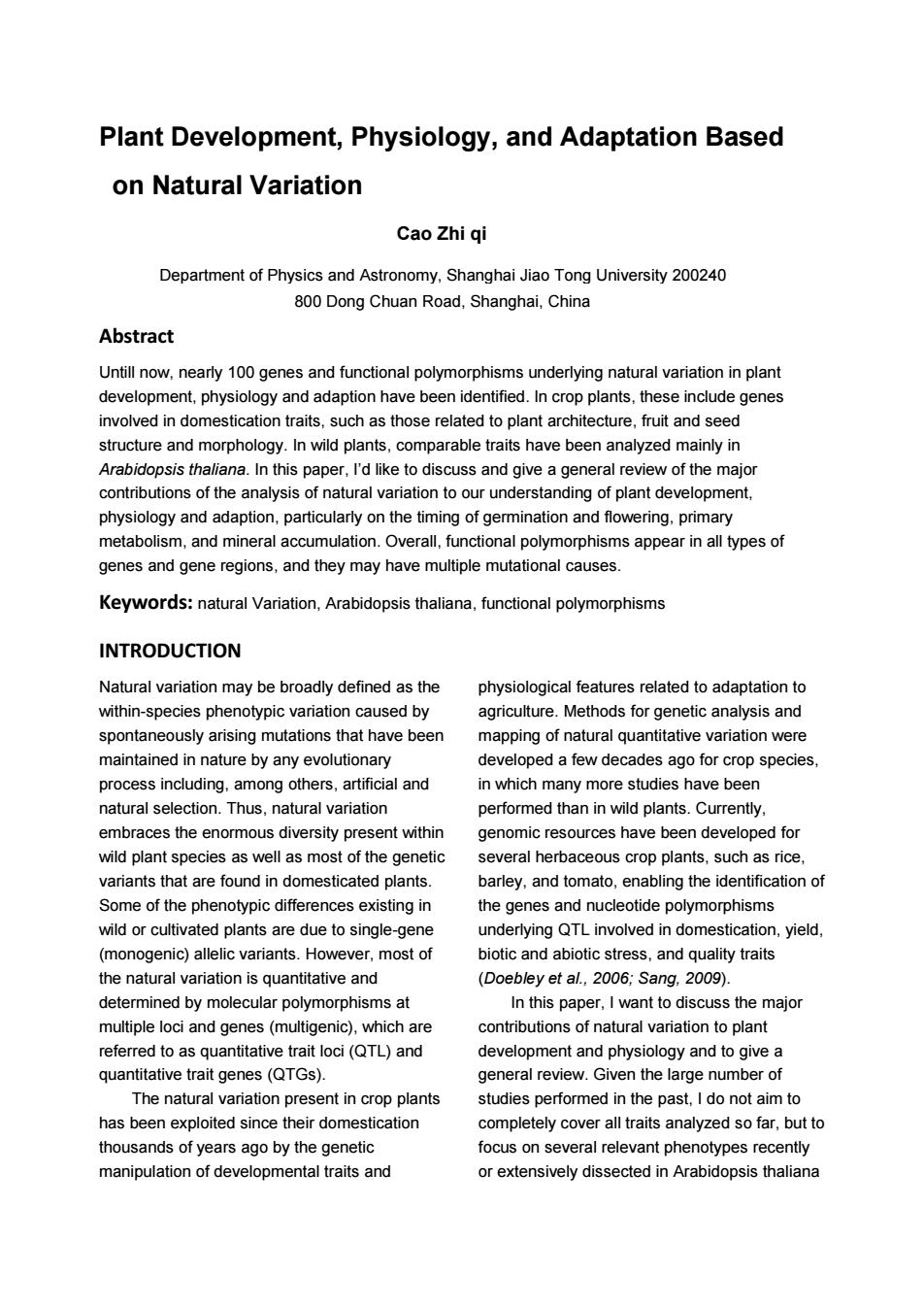
Plant Development,Physiology,and Adaptation Based on Natural Variation Cao Zhi qi Department of Physics and Astronomy,Shanghai Jiao Tong University 200240 800 Dong Chuan Road,Shanghai,China Abstract Untill now,nearly 100 genes and functional polymorphisms underlying natural variation in plant development,physiology and adaption have been identified.In crop plants,these include genes involved in domestication traits,such as those related to plant architecture,fruit and seed structure and morphology.In wild plants,comparable traits have been analyzed mainly in Arabidopsis thaliana.In this paper,I'd like to discuss and give a general review of the major contributions of the analysis of natural variation to our understanding of plant development, physiology and adaption,particularly on the timing of germination and flowering,primary metabolism,and mineral accumulation.Overall,functional polymorphisms appear in all types of genes and gene regions,and they may have multiple mutational causes. Keywords:natural Variation,Arabidopsis thaliana,functional polymorphisms INTRODUCTION Natural variation may be broadly defined as the physiological features related to adaptation to within-species phenotypic variation caused by agriculture.Methods for genetic analysis and spontaneously arising mutations that have been mapping of natural quantitative variation were maintained in nature by any evolutionary developed a few decades ago for crop species, process including,among others,artificial and in which many more studies have been natural selection.Thus,natural variation performed than in wild plants.Currently, embraces the enormous diversity present within genomic resources have been developed for wild plant species as well as most of the genetic several herbaceous crop plants,such as rice variants that are found in domesticated plants. barley,and tomato,enabling the identification of Some of the phenotypic differences existing in the genes and nucleotide polymorphisms wild or cultivated plants are due to single-gene underlying QTL involved in domestication,yield, (monogenic)allelic variants.However,most of biotic and abiotic stress,and quality traits the natural variation is quantitative and (Doebley et al.,2006;Sang,2009). determined by molecular polymorphisms at In this paper,I want to discuss the major multiple loci and genes(multigenic),which are contributions of natural variation to plant referred to as quantitative trait loci(QTL)and development and physiology and to give a quantitative trait genes (QTGs). general review.Given the large number of The natural variation present in crop plants studies performed in the past,I do not aim to has been exploited since their domestication completely cover all traits analyzed so far,but to thousands of years ago by the genetic focus on several relevant phenotypes recently manipulation of developmental traits and or extensively dissected in Arabidopsis thaliana
Plant Development, Physiology, and Adaptation Based on Natural Variation Cao Zhi qi Department of Physics and Astronomy, Shanghai Jiao Tong University 200240 800 Dong Chuan Road, Shanghai, China Abstract Untill now, nearly 100 genes and functional polymorphisms underlying natural variation in plant development, physiology and adaption have been identified. In crop plants, these include genes involved in domestication traits, such as those related to plant architecture, fruit and seed structure and morphology. In wild plants, comparable traits have been analyzed mainly in Arabidopsis thaliana. In this paper, I’d like to discuss and give a general review of the major contributions of the analysis of natural variation to our understanding of plant development, physiology and adaption, particularly on the timing of germination and flowering, primary metabolism, and mineral accumulation. Overall, functional polymorphisms appear in all types of genes and gene regions, and they may have multiple mutational causes. Keywords: natural Variation, Arabidopsis thaliana, functional polymorphisms INTRODUCTION Natural variation may be broadly defined as the within-species phenotypic variation caused by spontaneously arising mutations that have been maintained in nature by any evolutionary process including, among others, artificial and natural selection. Thus, natural variation embraces the enormous diversity present within wild plant species as well as most of the genetic variants that are found in domesticated plants. Some of the phenotypic differences existing in wild or cultivated plants are due to single-gene (monogenic) allelic variants. However, most of the natural variation is quantitative and determined by molecular polymorphisms at multiple loci and genes (multigenic), which are referred to as quantitative trait loci (QTL) and quantitative trait genes (QTGs). The natural variation present in crop plants has been exploited since their domestication thousands of years ago by the genetic manipulation of developmental traits and physiological features related to adaptation to agriculture. Methods for genetic analysis and mapping of natural quantitative variation were developed a few decades ago for crop species, in which many more studies have been performed than in wild plants. Currently, genomic resources have been developed for several herbaceous crop plants, such as rice, barley, and tomato, enabling the identification of the genes and nucleotide polymorphisms underlying QTL involved in domestication, yield, biotic and abiotic stress, and quality traits (Doebley et al., 2006; Sang, 2009). In this paper, I want to discuss the major contributions of natural variation to plant development and physiology and to give a general review. Given the large number of studies performed in the past, I do not aim to completely cover all traits analyzed so far, but to focus on several relevant phenotypes recently or extensively dissected in Arabidopsis thaliana
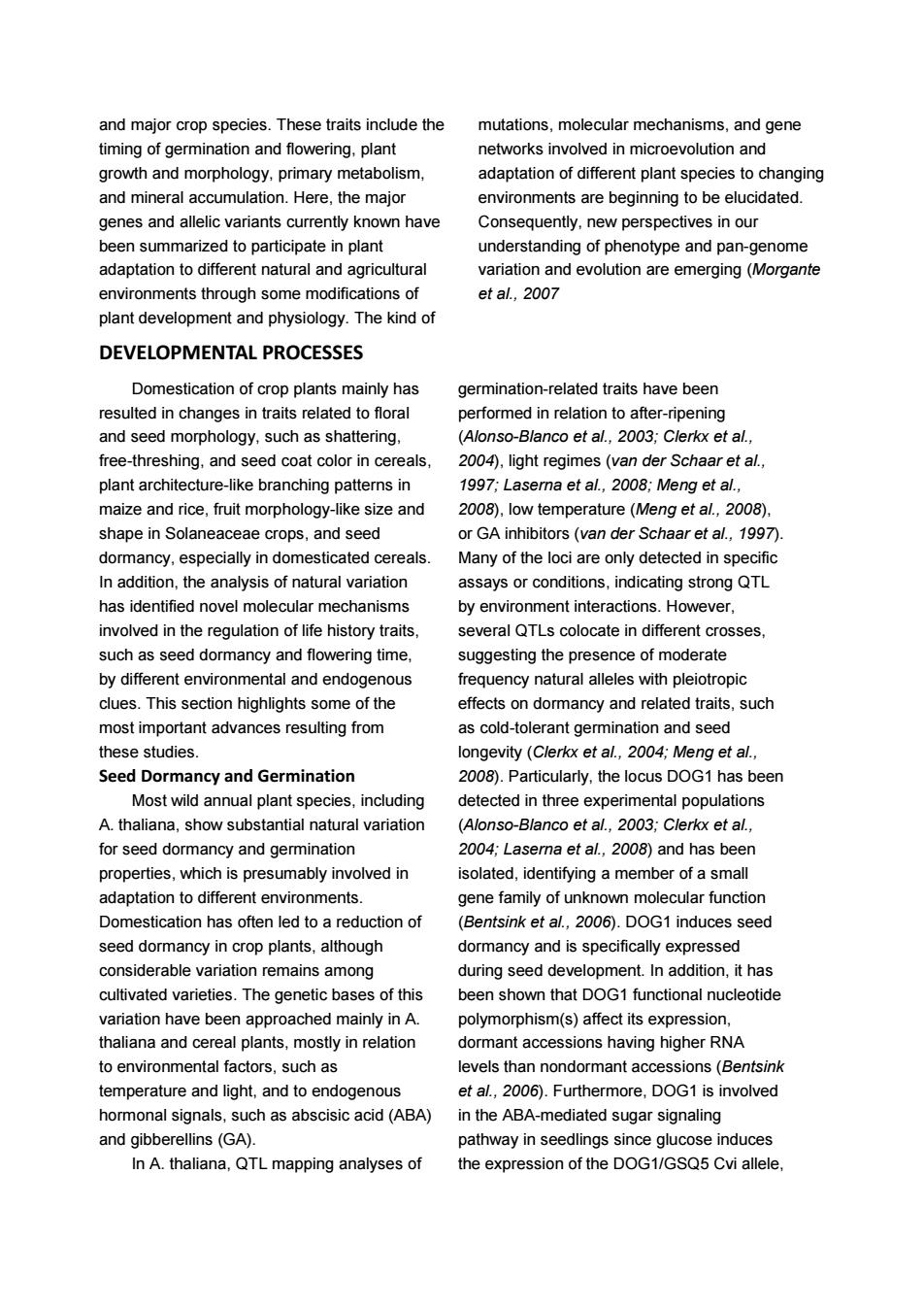
and major crop species.These traits include the mutations,molecular mechanisms,and gene timing of germination and flowering,plant networks involved in microevolution and growth and morphology,primary metabolism, adaptation of different plant species to changing and mineral accumulation.Here,the major environments are beginning to be elucidated. genes and allelic variants currently known have Consequently,new perspectives in our been summarized to participate in plant understanding of phenotype and pan-genome adaptation to different natural and agricultural variation and evolution are emerging(Morgante environments through some modifications of etal.,2007 plant development and physiology.The kind of DEVELOPMENTAL PROCESSES Domestication of crop plants mainly has germination-related traits have been resulted in changes in traits related to floral performed in relation to after-ripening and seed morphology,such as shattering, (Alonso-Blanco et al.,2003;Clerkx et al.. free-threshing,and seed coat color in cereals, 2004),light regimes (van der Schaar et al., plant architecture-like branching patterns in 1997;Laserna et al.,2008;Meng et al., maize and rice,fruit morphology-like size and 2008),low temperature(Meng et al.,2008). shape in Solaneaceae crops,and seed or GA inhibitors(van der Schaar et al.,1997). dormancy,especially in domesticated cereals. Many of the loci are only detected in specific In addition,the analysis of natural variation assays or conditions,indicating strong QTL has identified novel molecular mechanisms by environment interactions.However, involved in the regulation of life history traits, several QTLs colocate in different crosses, such as seed dormancy and flowering time, suggesting the presence of moderate by different environmental and endogenous frequency natural alleles with pleiotropic clues.This section highlights some of the effects on dormancy and related traits,such most important advances resulting from as cold-tolerant germination and seed these studies. longevity (Clerkx et al.,2004;Meng et al., Seed Dormancy and Germination 2008).Particularly,the locus DOG1 has been Most wild annual plant species,including detected in three experimental populations A.thaliana,show substantial natural variation (Alonso-Blanco et al.,2003;Clerkx et al. for seed dormancy and germination 2004;Laserna et al.,2008)and has been properties,which is presumably involved in isolated,identifying a member of a small adaptation to different environments. gene family of unknown molecular function Domestication has often led to a reduction of (Bentsink et al..2006).DOG1 induces seed seed dormancy in crop plants,although dormancy and is specifically expressed considerable variation remains among during seed development.In addition,it has cultivated varieties.The genetic bases of this been shown that DOG1 functional nucleotide variation have been approached mainly in A. polymorphism(s)affect its expression, thaliana and cereal plants,mostly in relation dormant accessions having higher RNA to environmental factors,such as levels than nondormant accessions (Bentsink temperature and light,and to endogenous et al..2006).Furthermore.DOG1 is involved hormonal signals,such as abscisic acid (ABA) in the ABA-mediated sugar signaling and gibberellins(GA). pathway in seedlings since glucose induces In A.thaliana,QTL mapping analyses of the expression of the DOG1/GSQ5 Cvi allele
and major crop species. These traits include the timing of germination and flowering, plant growth and morphology, primary metabolism, and mineral accumulation. Here, the major genes and allelic variants currently known have been summarized to participate in plant adaptation to different natural and agricultural environments through some modifications of plant development and physiology. The kind of mutations, molecular mechanisms, and gene networks involved in microevolution and adaptation of different plant species to changing environments are beginning to be elucidated. Consequently, new perspectives in our understanding of phenotype and pan-genome variation and evolution are emerging (Morgante et al., 2007 DEVELOPMENTAL PROCESSES Domestication of crop plants mainly has resulted in changes in traits related to floral and seed morphology, such as shattering, free-threshing, and seed coat color in cereals, plant architecture-like branching patterns in maize and rice, fruit morphology-like size and shape in Solaneaceae crops, and seed dormancy, especially in domesticated cereals. In addition, the analysis of natural variation has identified novel molecular mechanisms involved in the regulation of life history traits, such as seed dormancy and flowering time, by different environmental and endogenous clues. This section highlights some of the most important advances resulting from these studies. Seed Dormancy and Germination Most wild annual plant species, including A. thaliana, show substantial natural variation for seed dormancy and germination properties, which is presumably involved in adaptation to different environments. Domestication has often led to a reduction of seed dormancy in crop plants, although considerable variation remains among cultivated varieties. The genetic bases of this variation have been approached mainly in A. thaliana and cereal plants, mostly in relation to environmental factors, such as temperature and light, and to endogenous hormonal signals, such as abscisic acid (ABA) and gibberellins (GA). In A. thaliana, QTL mapping analyses of germination-related traits have been performed in relation to after-ripening (Alonso-Blanco et al., 2003; Clerkx et al., 2004), light regimes (van der Schaar et al., 1997; Laserna et al., 2008; Meng et al., 2008), low temperature (Meng et al., 2008), or GA inhibitors (van der Schaar et al., 1997). Many of the loci are only detected in specific assays or conditions, indicating strong QTL by environment interactions. However, several QTLs colocate in different crosses, suggesting the presence of moderate frequency natural alleles with pleiotropic effects on dormancy and related traits, such as cold-tolerant germination and seed longevity (Clerkx et al., 2004; Meng et al., 2008). Particularly, the locus DOG1 has been detected in three experimental populations (Alonso-Blanco et al., 2003; Clerkx et al., 2004; Laserna et al., 2008) and has been isolated, identifying a member of a small gene family of unknown molecular function (Bentsink et al., 2006). DOG1 induces seed dormancy and is specifically expressed during seed development. In addition, it has been shown that DOG1 functional nucleotide polymorphism(s) affect its expression, dormant accessions having higher RNA levels than nondormant accessions (Bentsink et al., 2006). Furthermore, DOG1 is involved in the ABA-mediated sugar signaling pathway in seedlings since glucose induces the expression of the DOG1/GSQ5 Cvi allele
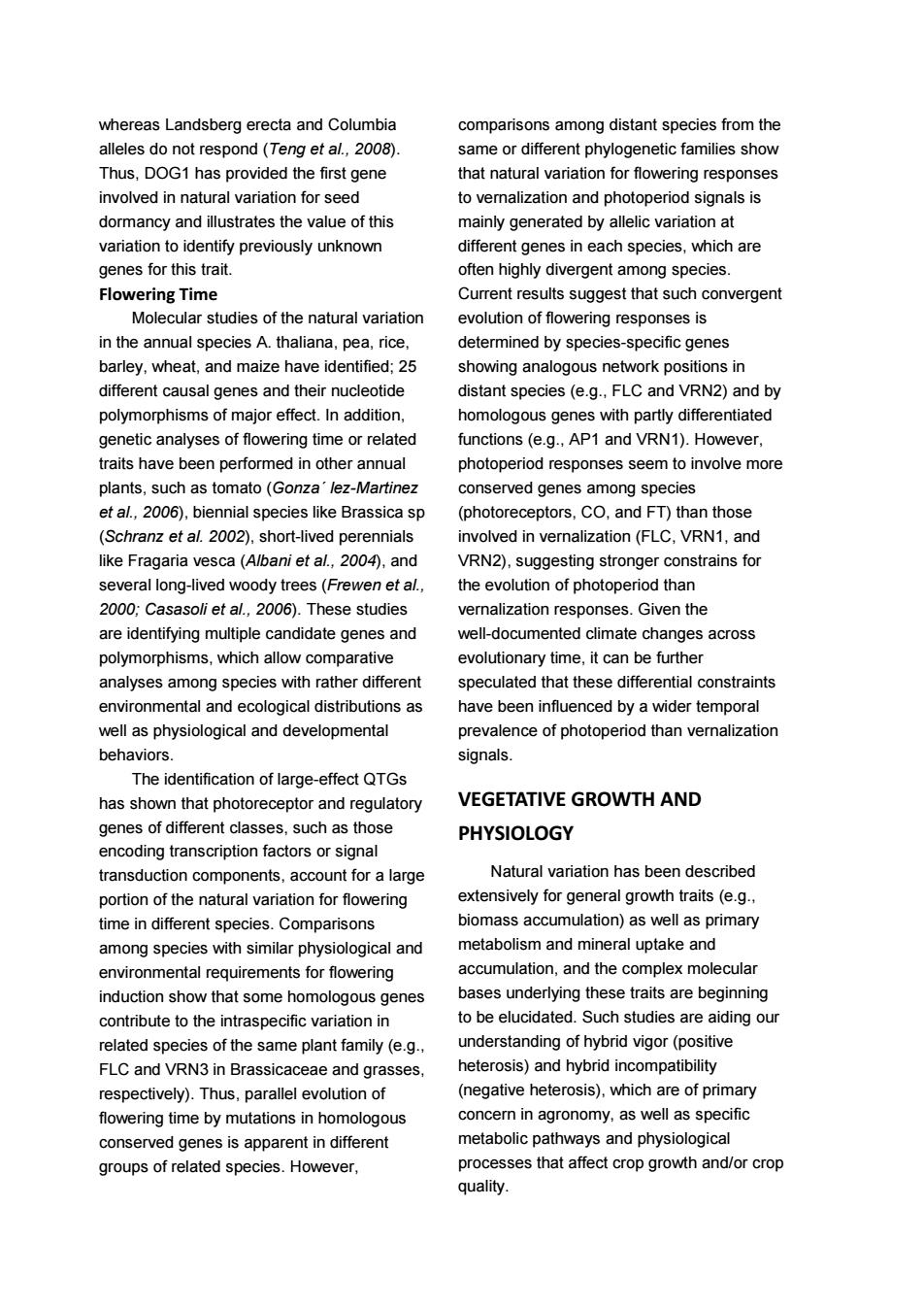
whereas Landsberg erecta and Columbia comparisons among distant species from the alleles do not respond(Teng et al.,2008) same or different phylogenetic families show Thus,DOG1 has provided the first gene that natural variation for flowering responses involved in natural variation for seed to vernalization and photoperiod signals is dormancy and illustrates the value of this mainly generated by allelic variation at variation to identify previously unknown different genes in each species,which are genes for this trait. often highly divergent among species. Flowering Time Current results suggest that such convergent Molecular studies of the natural variation evolution of flowering responses is in the annual species A.thaliana,pea,rice, determined by species-specific genes barley,wheat,and maize have identified;25 showing analogous network positions in different causal genes and their nucleotide distant species (e.g.,FLC and VRN2)and by polymorphisms of major effect.In addition. homologous genes with partly differentiated genetic analyses of flowering time or related functions(e.g.,AP1 and VRN1).However, traits have been performed in other annual photoperiod responses seem to involve more plants,such as tomato (Gonza'lez-Martinez conserved genes among species et al.,2006),biennial species like Brassica sp (photoreceptors,CO,and FT)than those (Schranz et al.2002),short-lived perennials involved in vernalization(FLC,VRN1,and like Fragaria vesca(Albani et al.,2004),and VRN2),suggesting stronger constrains for several long-lived woody trees(Frewen et al., the evolution of photoperiod than 2000;Casasoli et al.,2006).These studies vernalization responses.Given the are identifying multiple candidate genes and well-documented climate changes across polymorphisms,which allow comparative evolutionary time,it can be further analyses among species with rather different speculated that these differential constraints environmental and ecological distributions as have been influenced by a wider temporal well as physiological and developmental prevalence of photoperiod than vernalization behaviors. signals The identification of large-effect QTGs has shown that photoreceptor and regulatory VEGETATIVE GROWTH AND genes of different classes,such as those PHYSIOLOGY encoding transcription factors or signal transduction components,account for a large Natural variation has been described portion of the natural variation for flowering extensively for general growth traits(e.g., time in different species.Comparisons biomass accumulation)as well as primary among species with similar physiological and metabolism and mineral uptake and environmental requirements for flowering accumulation,and the complex molecular induction show that some homologous genes bases underlying these traits are beginning contribute to the intraspecific variation in to be elucidated.Such studies are aiding our related species of the same plant family (e.g., understanding of hybrid vigor(positive FLC and VRN3 in Brassicaceae and grasses, heterosis)and hybrid incompatibility respectively).Thus,parallel evolution of (negative heterosis),which are of primary flowering time by mutations in homologous concern in agronomy,as well as specific conserved genes is apparent in different metabolic pathways and physiological groups of related species.However, processes that affect crop growth and/or crop quality
whereas Landsberg erecta and Columbia alleles do not respond (Teng et al., 2008). Thus, DOG1 has provided the first gene involved in natural variation for seed dormancy and illustrates the value of this variation to identify previously unknown genes for this trait. Flowering Time Molecular studies of the natural variation in the annual species A. thaliana, pea, rice, barley, wheat, and maize have identified; 25 different causal genes and their nucleotide polymorphisms of major effect. In addition, genetic analyses of flowering time or related traits have been performed in other annual plants, such as tomato (Gonza´ lez-Martinez et al., 2006), biennial species like Brassica sp (Schranz et al. 2002), short-lived perennials like Fragaria vesca (Albani et al., 2004), and several long-lived woody trees (Frewen et al., 2000; Casasoli et al., 2006). These studies are identifying multiple candidate genes and polymorphisms, which allow comparative analyses among species with rather different environmental and ecological distributions as well as physiological and developmental behaviors. The identification of large-effect QTGs has shown that photoreceptor and regulatory genes of different classes, such as those encoding transcription factors or signal transduction components, account for a large portion of the natural variation for flowering time in different species. Comparisons among species with similar physiological and environmental requirements for flowering induction show that some homologous genes contribute to the intraspecific variation in related species of the same plant family (e.g., FLC and VRN3 in Brassicaceae and grasses, respectively). Thus, parallel evolution of flowering time by mutations in homologous conserved genes is apparent in different groups of related species. However, comparisons among distant species from the same or different phylogenetic families show that natural variation for flowering responses to vernalization and photoperiod signals is mainly generated by allelic variation at different genes in each species, which are often highly divergent among species. Current results suggest that such convergent evolution of flowering responses is determined by species-specific genes showing analogous network positions in distant species (e.g., FLC and VRN2) and by homologous genes with partly differentiated functions (e.g., AP1 and VRN1). However, photoperiod responses seem to involve more conserved genes among species (photoreceptors, CO, and FT) than those involved in vernalization (FLC, VRN1, and VRN2), suggesting stronger constrains for the evolution of photoperiod than vernalization responses. Given the well-documented climate changes across evolutionary time, it can be further speculated that these differential constraints have been influenced by a wider temporal prevalence of photoperiod than vernalization signals. VEGETATIVE GROWTH AND PHYSIOLOGY Natural variation has been described extensively for general growth traits (e.g., biomass accumulation) as well as primary metabolism and mineral uptake and accumulation, and the complex molecular bases underlying these traits are beginning to be elucidated. Such studies are aiding our understanding of hybrid vigor (positive heterosis) and hybrid incompatibility (negative heterosis), which are of primary concern in agronomy, as well as specific metabolic pathways and physiological processes that affect crop growth and/or crop quality
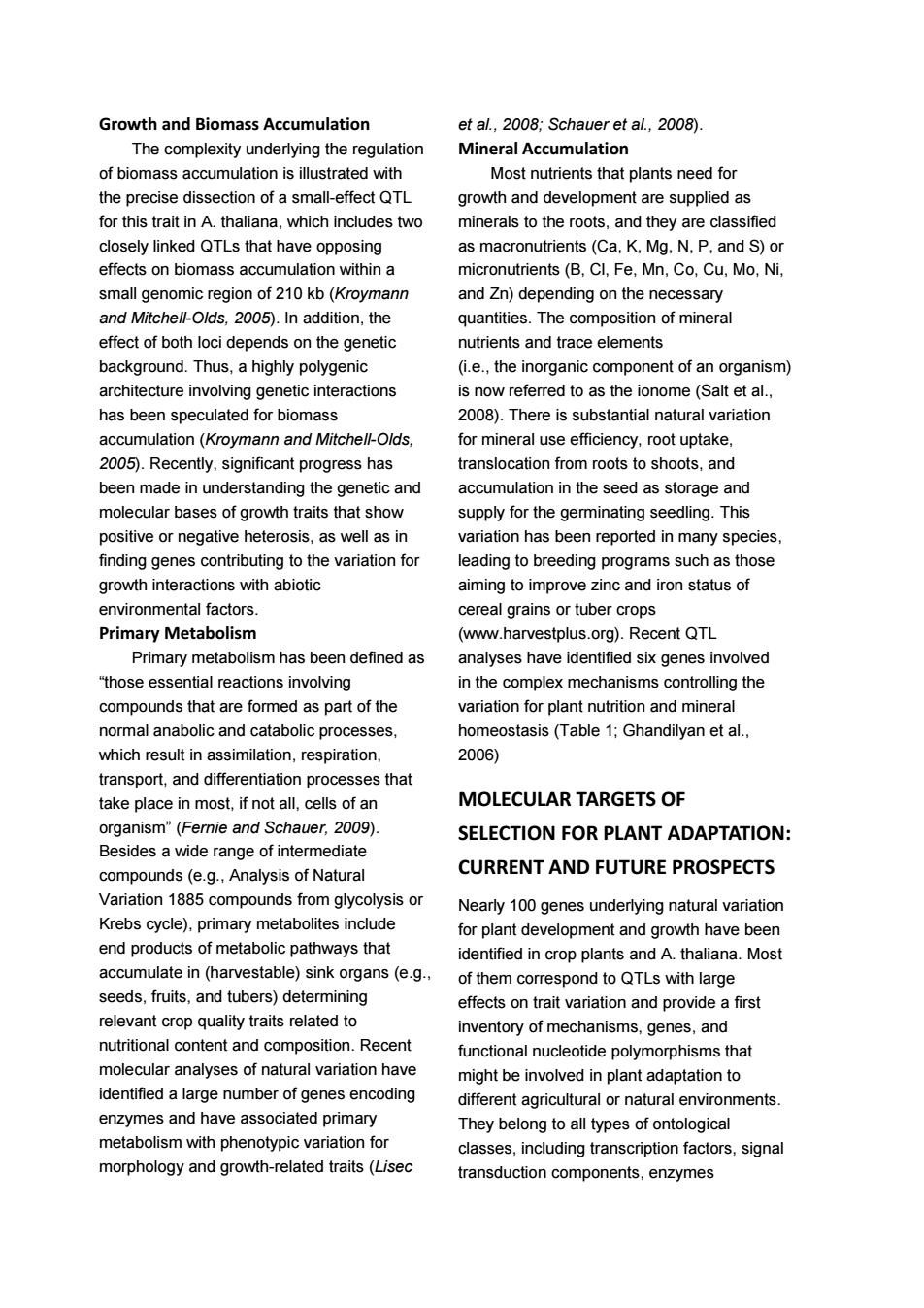
Growth and Biomass Accumulation et al..2008:Schauer et al..2008) The complexity underlying the regulation Mineral Accumulation of biomass accumulation is illustrated with Most nutrients that plants need for the precise dissection of a small-effect QTL growth and development are supplied as for this trait in A.thaliana,which includes two minerals to the roots,and they are classified closely linked QTLs that have opposing as macronutrients(Ca,K,Mg,N,P,and S)or effects on biomass accumulation within a micronutrients(B,Cl,Fe,Mn,Co,Cu,Mo,Ni, small genomic region of 210 kb(Kroymann and Zn)depending on the necessary and Mitchell-Olds,2005).In addition,the quantities.The composition of mineral effect of both loci depends on the genetic nutrients and trace elements background.Thus,a highly polygenic (i.e.,the inorganic component of an organism) architecture involving genetic interactions is now referred to as the ionome (Salt et al., has been speculated for biomass 2008).There is substantial natural variation accumulation (Kroymann and Mitchell-Olds, for mineral use efficiency,root uptake, 2005).Recently,significant progress has translocation from roots to shoots,and been made in understanding the genetic and accumulation in the seed as storage and molecular bases of growth traits that show supply for the germinating seedling.This positive or negative heterosis,as well as in variation has been reported in many species finding genes contributing to the variation for leading to breeding programs such as those growth interactions with abiotic aiming to improve zinc and iron status of environmental factors. cereal grains or tuber crops Primary Metabolism (www.harvestplus.org).Recent QTL Primary metabolism has been defined as analyses have identified six genes involved "those essential reactions involving in the complex mechanisms controlling the compounds that are formed as part of the variation for plant nutrition and mineral normal anabolic and catabolic processes. homeostasis (Table 1:Ghandilyan et al.. which result in assimilation,respiration, 2006) transport,and differentiation processes that take place in most,if not all,cells of an MOLECULAR TARGETS OF organism"(Fernie and Schauer,2009). SELECTION FOR PLANT ADAPTATION: Besides a wide range of intermediate compounds(e.g.,Analysis of Natural CURRENT AND FUTURE PROSPECTS Variation 1885 compounds from glycolysis or Nearly 100 genes underlying natural variation Krebs cycle),primary metabolites include for plant development and growth have been end products of metabolic pathways that identified in crop plants and A.thaliana.Most accumulate in(harvestable)sink organs (e.g., of them correspond to QTLs with large seeds,fruits,and tubers)determining effects on trait variation and provide a first relevant crop quality traits related to inventory of mechanisms,genes,and nutritional content and composition.Recent functional nucleotide polymorphisms that molecular analyses of natural variation have might be involved in plant adaptation to identified a large number of genes encoding different agricultural or natural environments enzymes and have associated primary They belong to all types of ontological metabolism with phenotypic variation for classes,including transcription factors,signal morphology and growth-related traits(Lisec transduction components,enzymes
Growth and Biomass Accumulation The complexity underlying the regulation of biomass accumulation is illustrated with the precise dissection of a small-effect QTL for this trait in A. thaliana, which includes two closely linked QTLs that have opposing effects on biomass accumulation within a small genomic region of 210 kb (Kroymann and Mitchell-Olds, 2005). In addition, the effect of both loci depends on the genetic background. Thus, a highly polygenic architecture involving genetic interactions has been speculated for biomass accumulation (Kroymann and Mitchell-Olds, 2005). Recently, significant progress has been made in understanding the genetic and molecular bases of growth traits that show positive or negative heterosis, as well as in finding genes contributing to the variation for growth interactions with abiotic environmental factors. Primary Metabolism Primary metabolism has been defined as “those essential reactions involving compounds that are formed as part of the normal anabolic and catabolic processes, which result in assimilation, respiration, transport, and differentiation processes that take place in most, if not all, cells of an organism” (Fernie and Schauer, 2009). Besides a wide range of intermediate compounds (e.g., Analysis of Natural Variation 1885 compounds from glycolysis or Krebs cycle), primary metabolites include end products of metabolic pathways that accumulate in (harvestable) sink organs (e.g., seeds, fruits, and tubers) determining relevant crop quality traits related to nutritional content and composition. Recent molecular analyses of natural variation have identified a large number of genes encoding enzymes and have associated primary metabolism with phenotypic variation for morphology and growth-related traits (Lisec et al., 2008; Schauer et al., 2008). Mineral Accumulation Most nutrients that plants need for growth and development are supplied as minerals to the roots, and they are classified as macronutrients (Ca, K, Mg, N, P, and S) or micronutrients (B, Cl, Fe, Mn, Co, Cu, Mo, Ni, and Zn) depending on the necessary quantities. The composition of mineral nutrients and trace elements (i.e., the inorganic component of an organism) is now referred to as the ionome (Salt et al., 2008). There is substantial natural variation for mineral use efficiency, root uptake, translocation from roots to shoots, and accumulation in the seed as storage and supply for the germinating seedling. This variation has been reported in many species, leading to breeding programs such as those aiming to improve zinc and iron status of cereal grains or tuber crops (www.harvestplus.org). Recent QTL analyses have identified six genes involved in the complex mechanisms controlling the variation for plant nutrition and mineral homeostasis (Table 1; Ghandilyan et al., 2006) MOLECULAR TARGETS OF SELECTION FOR PLANT ADAPTATION: CURRENT AND FUTURE PROSPECTS Nearly 100 genes underlying natural variation for plant development and growth have been identified in crop plants and A. thaliana. Most of them correspond to QTLs with large effects on trait variation and provide a first inventory of mechanisms, genes, and functional nucleotide polymorphisms that might be involved in plant adaptation to different agricultural or natural environments. They belong to all types of ontological classes, including transcription factors, signal transduction components, enzymes
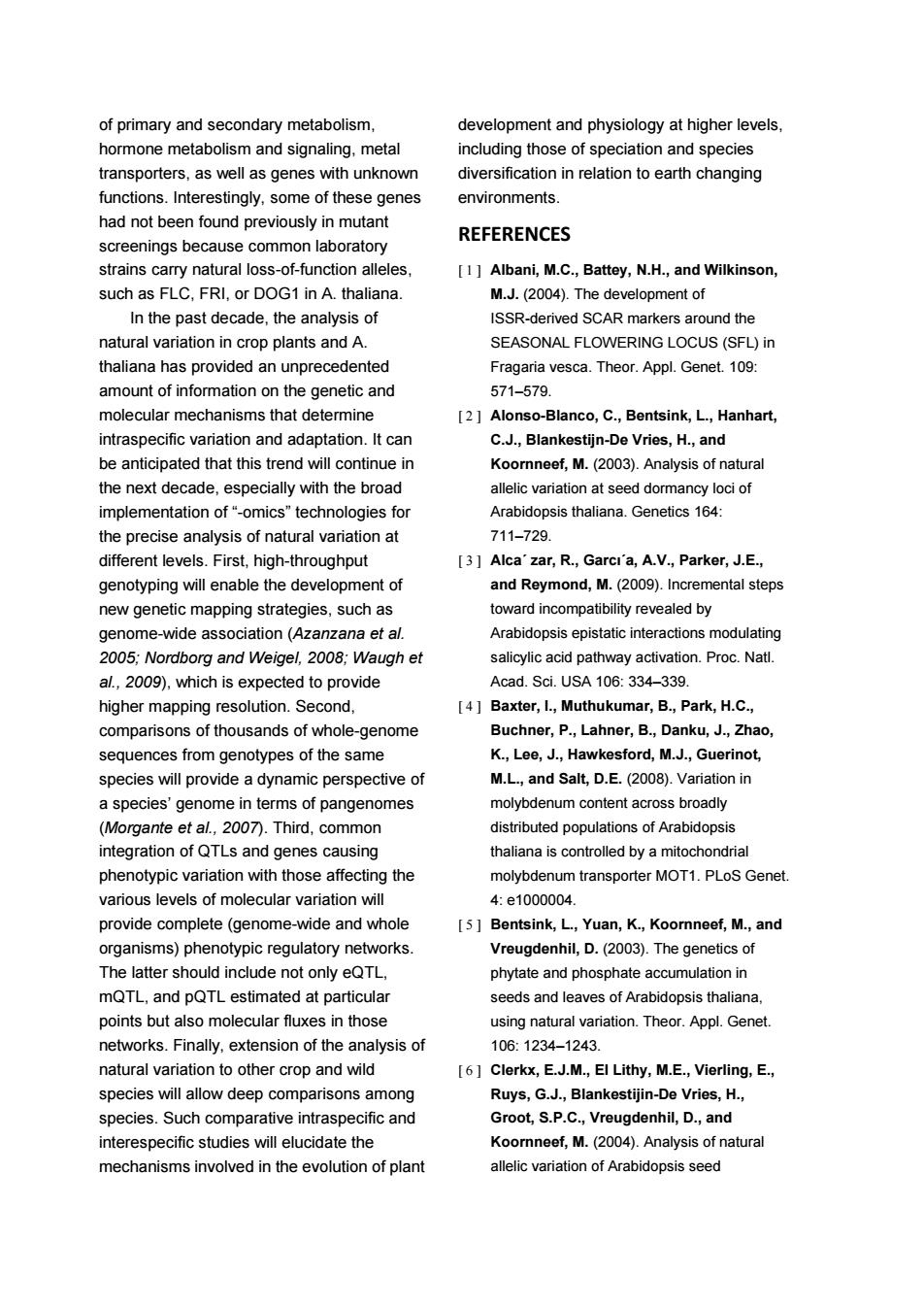
of primary and secondary metabolism, development and physiology at higher levels, hormone metabolism and signaling,metal including those of speciation and species transporters,as well as genes with unknown diversification in relation to earth changing functions.Interestingly,some of these genes environments. had not been found previously in mutant REFERENCES screenings because common laboratory strains carry natural loss-of-function alleles, [1 Albani,M.C.,Battey,N.H.,and Wilkinson, such as FLC,FRI.or DOG1 in A.thaliana. M.J.(2004).The development of In the past decade,the analysis of ISSR-derived SCAR markers around the natural variation in crop plants and A. SEASONAL FLOWERING LOCUS(SFL)in thaliana has provided an unprecedented Fragaria vesca.Theor.Appl.Genet.109: amount of information on the genetic and 571-579 molecular mechanisms that determine [2 Alonso-Blanco,C.,Bentsink,L.,Hanhart, intraspecific variation and adaptation.It can C.J.,Blankestijn-De Vries,H.,and be anticipated that this trend will continue in Koornneef,M.(2003).Analysis of natural the next decade,especially with the broad allelic variation at seed dormancy loci of implementation of"-omics"technologies for Arabidopsis thaliana.Genetics 164: the precise analysis of natural variation at 711-729. different levels.First,high-throughput [3 Alca'zar,R.,Garci'a,A.V.,Parker,J.E., genotyping will enable the development of and Reymond,M.(2009).Incremental steps new genetic mapping strategies,such as toward incompatibility revealed by genome-wide association(Azanzana et al. Arabidopsis epistatic interactions modulating 2005;Nordborg and Weigel,2008;Waugh et salicylic acid pathway activation.Proc.Natl. al.,2009),which is expected to provide Acad.Sci.USA 106:334-339. higher mapping resolution.Second, [4 Baxter,I.,Muthukumar,B.,Park,H.C., comparisons of thousands of whole-genome Buchner,P.,Lahner,B.,Danku,J.,Zhao, sequences from genotypes of the same K.,Lee,J.,Hawkesford,M.J.,Guerinot, species will provide a dynamic perspective of M.L.,and Salt,D.E.(2008).Variation in a species'genome in terms of pangenomes molybdenum content across broadly (Morgante et al.,2007).Third,common distributed populations of Arabidopsis integration of QTLs and genes causing thaliana is controlled by a mitochondrial phenotypic variation with those affecting the molybdenum transporter MOT1.PLoS Genet. various levels of molecular variation will 4:e1000004. provide complete (genome-wide and whole [5]Bentsink,L.,Yuan,K.,Koornneef,M.,and organisms)phenotypic regulatory networks. Vreugdenhil,D.(2003).The genetics of The latter should include not only eQTL, phytate and phosphate accumulation in mQTL,and pQTL estimated at particular seeds and leaves of Arabidopsis thaliana, points but also molecular fluxes in those using natural variation.Theor.Appl.Genet. networks.Finally,extension of the analysis of 106:1234-1243. natural variation to other crop and wild [6]Clerkx,E.J.M.,EI Lithy,M.E.,Vierling,E., species will allow deep comparisons among Ruys,G.J.,Blankestijin-De Vries,H., species.Such comparative intraspecific and Groot,S.P.C.,Vreugdenhil,D.,and interespecific studies will elucidate the Koornneef,M.(2004).Analysis of natural mechanisms involved in the evolution of plant allelic variation of Arabidopsis seed
of primary and secondary metabolism, hormone metabolism and signaling, metal transporters, as well as genes with unknown functions. Interestingly, some of these genes had not been found previously in mutant screenings because common laboratory strains carry natural loss-of-function alleles, such as FLC, FRI, or DOG1 in A. thaliana. In the past decade, the analysis of natural variation in crop plants and A. thaliana has provided an unprecedented amount of information on the genetic and molecular mechanisms that determine intraspecific variation and adaptation. It can be anticipated that this trend will continue in the next decade, especially with the broad implementation of “-omics” technologies for the precise analysis of natural variation at different levels. First, high-throughput genotyping will enable the development of new genetic mapping strategies, such as genome-wide association (Azanzana et al. 2005; Nordborg and Weigel, 2008; Waugh et al., 2009), which is expected to provide higher mapping resolution. Second, comparisons of thousands of whole-genome sequences from genotypes of the same species will provide a dynamic perspective of a species’ genome in terms of pangenomes (Morgante et al., 2007). Third, common integration of QTLs and genes causing phenotypic variation with those affecting the various levels of molecular variation will provide complete (genome-wide and whole organisms) phenotypic regulatory networks. The latter should include not only eQTL, mQTL, and pQTL estimated at particular points but also molecular fluxes in those networks. Finally, extension of the analysis of natural variation to other crop and wild species will allow deep comparisons among species. Such comparative intraspecific and interespecific studies will elucidate the mechanisms involved in the evolution of plant development and physiology at higher levels, including those of speciation and species diversification in relation to earth changing environments. REFERENCES [ 1 ] Albani, M.C., Battey, N.H., and Wilkinson, M.J. (2004). The development of ISSR-derived SCAR markers around the SEASONAL FLOWERING LOCUS (SFL) in Fragaria vesca. Theor. Appl. Genet. 109: 571–579. [ 2 ] Alonso-Blanco, C., Bentsink, L., Hanhart, C.J., Blankestijn-De Vries, H., and Koornneef, M. (2003). Analysis of natural allelic variation at seed dormancy loci of Arabidopsis thaliana. Genetics 164: 711–729. [ 3 ] Alca´ zar, R., Garcı´a, A.V., Parker, J.E., and Reymond, M. (2009). Incremental steps toward incompatibility revealed by Arabidopsis epistatic interactions modulating salicylic acid pathway activation. Proc. Natl. Acad. Sci. USA 106: 334–339. [ 4 ] Baxter, I., Muthukumar, B., Park, H.C., Buchner, P., Lahner, B., Danku, J., Zhao, K., Lee, J., Hawkesford, M.J., Guerinot, M.L., and Salt, D.E. (2008). Variation in molybdenum content across broadly distributed populations of Arabidopsis thaliana is controlled by a mitochondrial molybdenum transporter MOT1. PLoS Genet. 4: e1000004. [ 5 ] Bentsink, L., Yuan, K., Koornneef, M., and Vreugdenhil, D. (2003). The genetics of phytate and phosphate accumulation in seeds and leaves of Arabidopsis thaliana, using natural variation. Theor. Appl. Genet. 106: 1234–1243. [ 6 ] Clerkx, E.J.M., El Lithy, M.E., Vierling, E., Ruys, G.J., Blankestijin-De Vries, H., Groot, S.P.C., Vreugdenhil, D., and Koornneef, M. (2004). Analysis of natural allelic variation of Arabidopsis seed
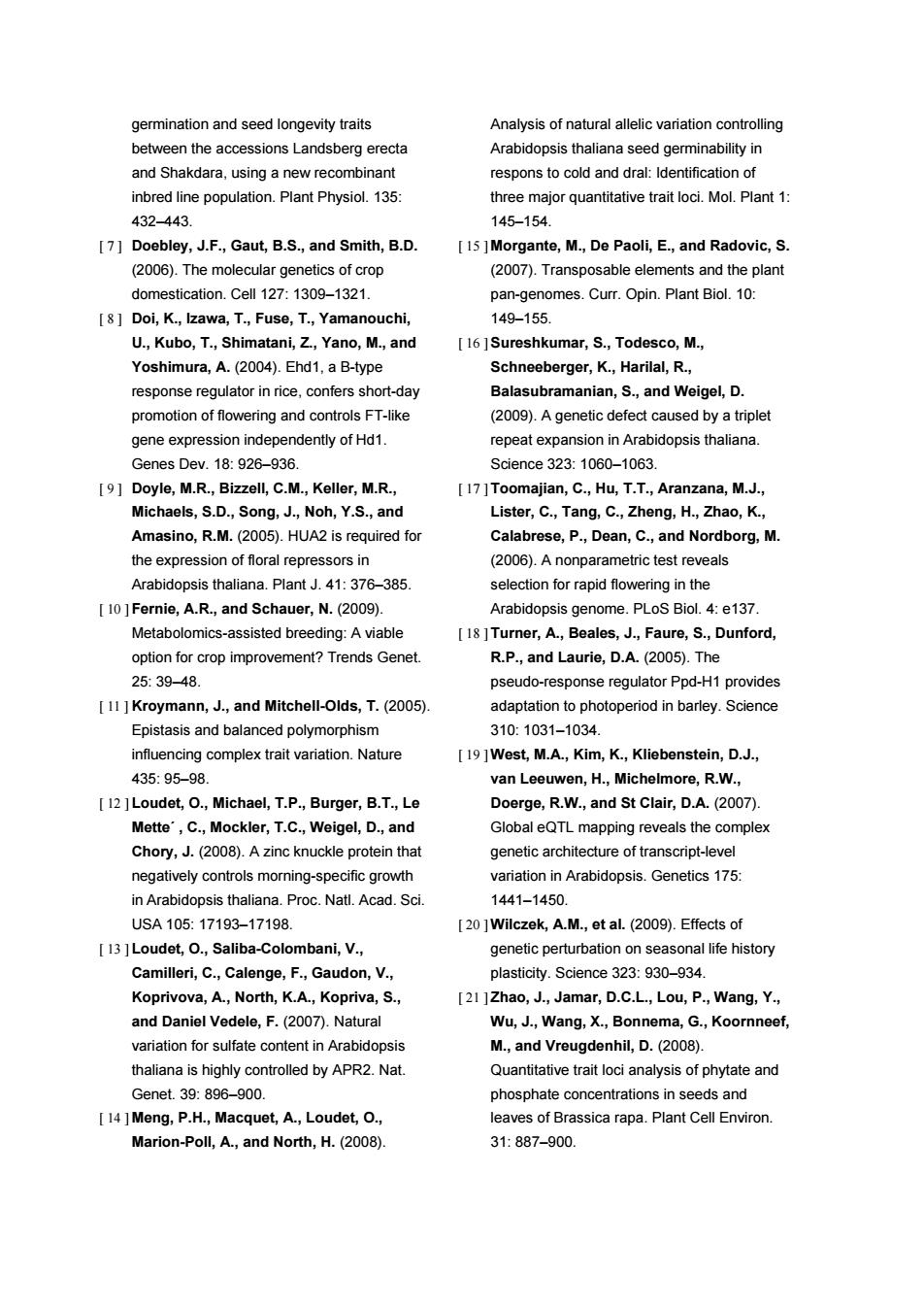
germination and seed longevity traits Analysis of natural allelic variation controlling between the accessions Landsberg erecta Arabidopsis thaliana seed germinability in and Shakdara,using a new recombinant respons to cold and dral:Identification of inbred line population.Plant Physiol.135: three major quantitative trait loci.Mol.Plant 1: 432-443. 145-154. [7]Doebley,J.F.,Gaut,B.S.,and Smith,B.D. [15 ]Morgante,M.,De Paoli,E.,and Radovic,S. (2006).The molecular genetics of crop (2007).Transposable elements and the plant domestication.Cell 127:1309-1321. pan-genomes.Curr.Opin.Plant Biol.10: [8]Doi,K.,Izawa,T.,Fuse,T.,Yamanouchi, 149-155. U.,Kubo,T.,Shimatani,Z.,Yano,M.,and [16 ]Sureshkumar,S.,Todesco,M., Yoshimura,A.(2004).Ehd1,a B-type Schneeberger,K.,Harilal,R., response regulator in rice,confers short-day Balasubramanian,S.,and Weigel,D. promotion of flowering and controls FT-like (2009).A genetic defect caused by a triplet gene expression independently of Hd1. repeat expansion in Arabidopsis thaliana. Genes Dev.18:926-936. Science323:1060-1063. 9]Doyle,M.R.,Bizzell,C.M.,Keller,M.R., [17]Toomajian,C.,Hu,T.T.,Aranzana,M.J., Michaels,S.D.,Song,J.,Noh,Y.S.,and Lister,C.,Tang,C.,Zheng,H.,Zhao,K., Amasino,R.M.(2005).HUA2 is required for Calabrese,P.,Dean,C.,and Nordborg,M. the expression of floral repressors in (2006).A nonparametric test reveals Arabidopsis thaliana.Plant J.41:376-385. selection for rapid flowering in the [10 ]Fernie,A.R.,and Schauer,N.(2009). Arabidopsis genome.PLoS Biol.4:e137. Metabolomics-assisted breeding:A viable [18 ]Turner,A.,Beales,J.,Faure,S.,Dunford, option for crop improvement?Trends Genet. R.P.,and Laurie,D.A.(2005).The 25:39-48. pseudo-response regulator Ppd-H1 provides [11 Kroymann,J.,and Mitchell-Olds,T.(2005). adaptation to photoperiod in barley.Science Epistasis and balanced polymorphism 310:1031-1034. influencing complex trait variation.Nature [19 ]West,M.A.,Kim,K.,Kliebenstein,D.J., 435:95-98 van Leeuwen,H.,Michelmore,R.W., [12 ]Loudet,O.,Michael,T.P.,Burger,B.T.,Le Doerge,R.W.,and St Clair,D.A.(2007). Mette,C.,Mockler,T.C.,Weigel,D.,and Global eQTL mapping reveals the complex Chory,J.(2008).A zinc knuckle protein that genetic architecture of transcript-level negatively controls morning-specific growth variation in Arabidopsis.Genetics 175: in Arabidopsis thaliana.Proc.Natl.Acad.Sci. 1441-1450. USA105:17193-17198, 20 ]Wilczek,A.M.,et al.(2009).Effects of [13 ]Loudet,O.,Saliba-Colombani,V., genetic perturbation on seasonal life history Camilleri,C.,Calenge,F.,Gaudon,V., plasticity.Science 323:930-934. Koprivova,A.,North,K.A.,Kopriva,S., [21 ]Zhao,J.,Jamar,D.C.L.,Lou,P.,Wang,Y., and Daniel Vedele,F.(2007).Natural Wu,J.,Wang,X.,Bonnema,G.,Koornneef, variation for sulfate content in Arabidopsis M.,and Vreugdenhil,D.(2008) thaliana is highly controlled by APR2.Nat. Quantitative trait loci analysis of phytate and Genet..39:896-900. phosphate concentrations in seeds and [14 ]Meng,P.H.,Macquet,A.,Loudet,O., leaves of Brassica rapa.Plant Cell Environ. Marion-Poll,A.,and North,H.(2008). 31:887-900
germination and seed longevity traits between the accessions Landsberg erecta and Shakdara, using a new recombinant inbred line population. Plant Physiol. 135: 432–443. [ 7 ] Doebley, J.F., Gaut, B.S., and Smith, B.D. (2006). The molecular genetics of crop domestication. Cell 127: 1309–1321. [ 8 ] Doi, K., Izawa, T., Fuse, T., Yamanouchi, U., Kubo, T., Shimatani, Z., Yano, M., and Yoshimura, A. (2004). Ehd1, a B-type response regulator in rice, confers short-day promotion of flowering and controls FT-like gene expression independently of Hd1. Genes Dev. 18: 926–936. [ 9 ] Doyle, M.R., Bizzell, C.M., Keller, M.R., Michaels, S.D., Song, J., Noh, Y.S., and Amasino, R.M. (2005). HUA2 is required for the expression of floral repressors in Arabidopsis thaliana. Plant J. 41: 376–385. [ 10 ] Fernie, A.R., and Schauer, N. (2009). Metabolomics-assisted breeding: A viable option for crop improvement? Trends Genet. 25: 39–48. [ 11 ] Kroymann, J., and Mitchell-Olds, T. (2005). Epistasis and balanced polymorphism influencing complex trait variation. Nature 435: 95–98. [ 12 ] Loudet, O., Michael, T.P., Burger, B.T., Le Mette´ , C., Mockler, T.C., Weigel, D., and Chory, J. (2008). A zinc knuckle protein that negatively controls morning-specific growth in Arabidopsis thaliana. Proc. Natl. Acad. Sci. USA 105: 17193–17198. [ 13 ] Loudet, O., Saliba-Colombani, V., Camilleri, C., Calenge, F., Gaudon, V., Koprivova, A., North, K.A., Kopriva, S., and Daniel Vedele, F. (2007). Natural variation for sulfate content in Arabidopsis thaliana is highly controlled by APR2. Nat. Genet. 39: 896–900. [ 14 ] Meng, P.H., Macquet, A., Loudet, O., Marion-Poll, A., and North, H. (2008). Analysis of natural allelic variation controlling Arabidopsis thaliana seed germinability in respons to cold and dral: Identification of three major quantitative trait loci. Mol. Plant 1: 145–154. [ 15 ] Morgante, M., De Paoli, E., and Radovic, S. (2007). Transposable elements and the plant pan-genomes. Curr. Opin. Plant Biol. 10: 149–155. [ 16 ]Sureshkumar, S., Todesco, M., Schneeberger, K., Harilal, R., Balasubramanian, S., and Weigel, D. (2009). A genetic defect caused by a triplet repeat expansion in Arabidopsis thaliana. Science 323: 1060–1063. [ 17 ] Toomajian, C., Hu, T.T., Aranzana, M.J., Lister, C., Tang, C., Zheng, H., Zhao, K., Calabrese, P., Dean, C., and Nordborg, M. (2006). A nonparametric test reveals selection for rapid flowering in the Arabidopsis genome. PLoS Biol. 4: e137. [ 18 ] Turner, A., Beales, J., Faure, S., Dunford, R.P., and Laurie, D.A. (2005). The pseudo-response regulator Ppd-H1 provides adaptation to photoperiod in barley. Science 310: 1031–1034. [ 19 ] West, M.A., Kim, K., Kliebenstein, D.J., van Leeuwen, H., Michelmore, R.W., Doerge, R.W., and St Clair, D.A. (2007). Global eQTL mapping reveals the complex genetic architecture of transcript-level variation in Arabidopsis. Genetics 175: 1441–1450. [ 20 ] Wilczek, A.M., et al. (2009). Effects of genetic perturbation on seasonal life history plasticity. Science 323: 930–934. [ 21 ] Zhao, J., Jamar, D.C.L., Lou, P., Wang, Y., Wu, J., Wang, X., Bonnema, G., Koornneef, M., and Vreugdenhil, D. (2008). Quantitative trait loci analysis of phytate and phosphate concentrations in seeds and leaves of Brassica rapa. Plant Cell Environ. 31: 887–900